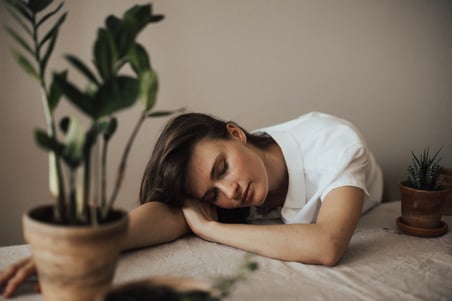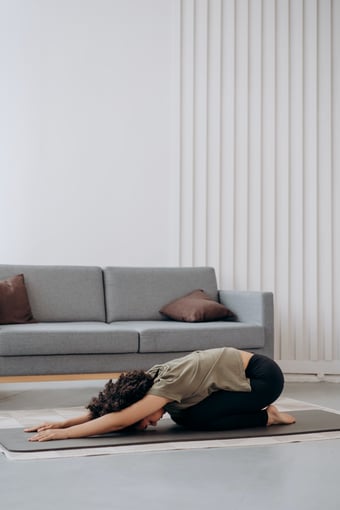How Weather Affects Our Mental Health: Gearing Up for Winter in Chicagoland

Alright folks, if you haven’t done it yet it is time to break out the vitamin D and prepare for our winter months. Why you ask? I’d love to tell you!
Vitamin D is a pretty important nutrient for our bodies that plays a big role in our mental health. It is directly linked to diagnosis such as depression and anxiety, and if you live in an area that does not get a lot of sunlight (lookin’ at you Chicagoland, Michigan, Vermont, Washington…) then you might find yourself experiencing some vitamin deficiencies during the winter months.

Lack of vitamin D and physical activity can result in a “special” type of depression called Seasonal Affective Disorder (which is shortened to its acronym, S.A.D, which sometimes you just have to laugh at the irony). The American Psychiatric Association estimates that about 5% of Americans experience S.A.D. yearly (Torres, 2020). Mayo Clinic (2021) lists symptoms of S.A.D that include:
- Feeling listless, sad or down most of the day, nearly every day
- Losing interest in activities you once enjoyed
- Having low energy and feeling sluggish
- Having problems with sleeping too much
- Experiencing carbohydrate cravings, overeating and weight gain
- Having difficulty concentrating
- Feeling hopeless, worthless or guilty
- Having thoughts of not wanting to live

Seasonal Affective Disorder is most commonly discussed during the Fall and Winter months, as it is reported symptoms increase exponentially around these times of year, however some individuals may also develop S.A.D. during the Spring and Summer months. Fall and Winter symptoms also include behaviors like over sleeping, appetite changes, weight gain, low energy, and fatigue. Spring and Summer S.A.D. also experience these symptoms but those individuals may also experience heightened anxiety and irritability.
What causes Seasonal Affective Disorder? Is it just lack of sunlight? The short answer is…kind of! Lack of sunlight seems pretty basic and not that dramatic, however the science behind the benefits of sunlight are fascinating. The frustrating thing is we cannot specifically feel when these changes start happening, so it is important to be informed for preventative purposes. So, HOW does the sun make us happy?
During exposure to sunlight, 7-dehydrocholoserol in the skin absorbs UVB radiation and is converted to previtamin D3, which in turn isomerizes in vitamin D3 (Wacker & Holick, 2013). It is then metabolized in the liver and kidneys resulting in the regulation of calcium and and phosphate metabolism which maintains metabolic functions and skeletal health. Vitamin D is considered to be a crucial nutrient for calcium absorption and homeostasis, thus influencing bone health and metabolism (Guzek et al, 2021). If you are curious about the deeper details of how vitamin D metabolizes and the different health functions it benefits, I encourage you to read Wacker and Holick's journal article cited below, which goes into interesting detail describing what we’ve learned about this important vitamin throughout history.
Location plays a key role regarding how much sunlight we can get depending on the time of year. Something Chicagoland natives (and many others) experience are biyearly daylight savings time changes. In the Fall we “fall back” by an hour, resulting in reducing our ability to get more sunlight and instead the sun sets around 4:00-5:00 in the evening. For the majority of us that have to wake up early when the sun is just rising, and then leave school or work around 4:00-5:00pm, we already are at a disadvantage for months to get the sunlight and vitamin D we need.
Key Factors to Focus on to Help Prevent Depressive Symptoms in the Winter:
SLEEP CYCLES
One contributing factor to depression is having irregular sleep cycles, and unfortunately lack of sunlight can affect our circadian rhythm. It can also decrease levels of serotonin and melatonin, serotonin affecting our mood and melatonin affecting our sleep cycles. Getting enough sleep is crucial for our mental and physical health, if you are not getting the recommended 7-8 hours of sleep per night you can talk to a healthcare or mental healthcare professional to obtain tools (such as meditation techniques or breathing techniques, as well as general information regarding how to get more sleep), obtain supplements, or possibly medication.
STAYING ACTIVE (you don’t need to be a marathon runner, but hear me out…)
Being active keeps our metabolism going and can help our overall mood and physical health. However, winter tends to put locals into what I call “hibernation mode” where we stay inside and bundle up, embracing our lazy side. This does not count as the type of activity we need in the Winter (as much as we try to justify it!).
I know, I know, “but Kelly, it’s gray and cold out, this is perfect curl-up-on-the-couch-in-pjs-and-binge-watch-tv-all-day weather!” It’s all about balance, having some time to rest and time to be active. Being sedentary can lead to symptoms of depression so overall you want to include some type of physical activity at minimum 10-20 minutes a day. I’ve organized some ideas between two types of individuals:
I LOVE BEING PHYSICALLY ACTIVE!
- Go for a run, jog, or walk (sign up for the holiday 5k!)
- Join gyms that have fun classes- the more competitive the better
- I hear crossfit is a thing, have you given that a shot?

- Winter hikes can be fun, and beautiful. Gear up and drag your best friend out on a hike, misery loves company, right? (Or if you don’t really like people, go alone, it’ll be equally as nice)
- Rock climb. You never know when you’ll need to scale a mountain to get away from your enemies.
- If you live in a particularly snowy area, go ski, snowboard, break out your sled!
I DON’T LOVE BEING PHYSICALLY ACTIVE!
- Stretch! Here is an example video of a 15-minute stretch routine
- Play with your pet, bonus points if you can take it on a walk
- Dance! YouTube has so many different videos which can be high intensity or low, whatever you’re in the mood for that day. If you don’t want to watch a video just do some interpretive dance, it’s an art form after all.
- Do a set of pushups. Or crunches. Do the splits if you’d like. It’s your life, you get to choose!
- Do you have kids? Or a dog? Chase them around the house, they love that and you’ll get a workout, it’s basically a win-win
- Instead of sitting while you are working, stand, or get a physio ball
- Pilates or Yoga—these are awesome because they come in many variations of intensity. Here are some examples you can do from home:
DIET
There are several food choices you can include in your diet to help your levels of vitamin D naturally. An article on Healthline.com (Jones, 2023) lists 7 different foods that you can consume if you are worried about getting enough vitamin D:
- Fatty fish such as salmon, mackerel, halibut, and sardines (canned tuna works too!)
- Fish Oils
- Egg Yolks
- Mushrooms
- Vitamin D fortified foods such as cows milk, soy milk, orange juice, cereal or oatmeal
LIGHT
Light therapy is also another benefit during the winter months. Let’s face it, when it’s 20 degrees outside it can be difficult to get the recommended 20-30 minutes daily dose of vitamin D from sunlight. Not only do we not want to be out in the cold, we’re layered up, so skin exposure is limited. Luckily scientists were able to replicate this light for the indoors with the use of light boxes or light lamps that replicate rays from the sun while you are sitting indoors. If you’re unsure what kind of light box to get it is recommended to talk to a healthcare professional or compare different models to see what would best fit your needs. Good Housekeeping has a list of the best light boxes in 2023, check it out here if you would like to start your research.
when it’s 20 degrees outside it can be difficult to get the recommended 20-30 minutes daily dose of vitamin D from sunlight. Not only do we not want to be out in the cold, we’re layered up, so skin exposure is limited. Luckily scientists were able to replicate this light for the indoors with the use of light boxes or light lamps that replicate rays from the sun while you are sitting indoors. If you’re unsure what kind of light box to get it is recommended to talk to a healthcare professional or compare different models to see what would best fit your needs. Good Housekeeping has a list of the best light boxes in 2023, check it out here if you would like to start your research.
When should I see a doctor?
If you are noticing that you are more fatigued or lethargic than usual, if normal activities don’t strike your interest anymore, if you have a lack of motivation to complete tasks, if you feel sad or down, if you feel like harming yourself or others, if you notice you are sleeping more, and if you notice you are eating more or less, talk to a healthcare professional. A good thing about the possibility of having depression due to a chemical imbalance due to a vitamin deficiency is that a quick blood test can confirm if this is the case. The first step is to make an appointment with your primary care provider for a vitamin panel blood draw which will conclude if you have a deficiency. If it is found that you have a vitamin D deficiency you can talk with your prescriber about a prescription vitamin D (over the counter vitamin D does not contain the same amount as a medical prescription!).
You should also reach out to a mental health professional in case there are other circumstances affecting your symptoms. According to NAMI, an individual can be diagnosed with S.A.D. if they experience these symptoms for a four-month duration, over two or more years (NAMI, 2017). The goal overall is to decrease symptoms so be sure to advocate for yourself!
There are many pros and cons to being able to experience these cold and gray seasons, but when it comes to your mental health it is important to be informed of the cons so we can get ahead of them and prevent any unnecessary mood changes or behavior struggles. If you have any questions regarding any of this information, or would like to chat with a mental health professional regarding any symptoms you might be experiencing, please feel free to reach out to this writer directly at klaporte@napervillecounseling.com.

References
Guzek, D., Kolota, A., Lachowicz, K., Skolmowska, D., Stachon, M., & Głąbska, D. (2021). Association between Vitamin D Supplementation and Mental Health in Healthy Adults: A Systematic Review. National Library of Medicine, 10(3), 5156. https://doi.org/10.3390/jcm10215156
Jones, T., RD (2023, July 6). 7 Nutritious Foods That Are High in Vitamin D. Healthline. Retrieved September 17, 2023, from https://www.healthline.com/nutrition/9-foods-high-in-vitamin-d
Krstic, Z., & Lipski, O. (2022, February 28). 7 Best Light Therapy Lamps, According to Experts. Good Housekeeping. Retrieved September 17, 2023, from https://www.goodhousekeeping.com/health-products/g32980654/best-light-therapy-lamps/
(2021, December 14). Seasonal Affective Disorder (SAD). Mayo Clinic. Retrieved September 18, 2023, from https://www.mayoclinic.org/diseases-conditions/seasonal-affective-disorder/symptoms-causes/syc-20364651
(2017, August 1). Major Depressive Disorder with Seasonal Pattern. NAMI. Retrieved September 18, 2023, from https://www.nami.org/About-Mental-Illness/Mental-Health-Conditions/Depression/Major-Depressive-Disorder-with-a-Seasonal-Pattern
Torres, F., MD, MBA, DFAPA (2020, October 1). Seasonal Affective Disorder (SAD). American Psychiatric Association. Retrieved September 18, 2023, from https://www.psychiatry.org/Patients-Families/Seasonal-Affective-Disorder
Wacker, M., & Holick, M. F. (2013). Sunlight and Vitamin D. Dermato Endocrinology, 5(1), 51-108. https://doi.org/10.4161/derm.24494

